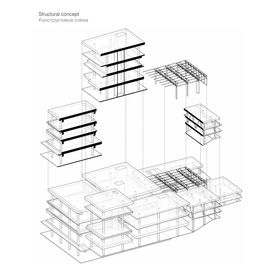
Museum of Revolution of Dignity
type: Museum, landscape design
location: Kyiv, Ukraine
year: 2018
status: International Competition, II prize
collaborators: ECOTHERMO ENGINEERING, CONC.
size: 12 000sq.m
authors: Oleksandr Abrosimov, Mihail Churilov, Yaroslava Dubova, Sergiy Ferley, Viktor Fomin, Anton Gerasymovych, Dmytro Gurin, Dmytro Makahon, Denys Matviienko, Anton Oliinyk, Maria Pakhomova, Oleksii Pakhomov, Anna Potanina, Iegor Shtefan, Nataliia Shulga, Oleksandr Sidnev, Olha Valkova, Anna Viken, Volodymyr Vustianskyi
The Museum will interconnect several neighboring quarters, fully unlocking their previously ignored potential. The Museum will also become a focus point between numerous institutions located nearby. The new network of walkways will stitch together the Parliament, the Presidential Administration, the Government Quarter and the Maidan as a territory of unity and a symbol of direct democracy. The fence between the Government building and the House of Freedom will be taken down as an ethically impossible symbol. The existing garden of the Government house will become open to the public along with the Museum’s courtyard. The upper gallery of the House of Freedom will offer a direct connection with the Government building’s side arch. As a result, the complex will create an almost uninterrupted chain of public spaces from the Maidan to the historic Mariinsky park, incorporating the parks along the Dnieper. Two more routes will open from the sides of the Museum: one connecting the Heavenly Hundred lane and the Muzeyni Provulok street, and another providing a direct link between the National Art Museum and the Khreschatik subway station. The latter route will pass straight through the Museum, allowing the House of Freedom and the National Art Museum to hold joint events. The building can be accessed by transport from Muzeyni Provulok street. All plots of land related to the overall project are either state- or city-owned. The shape of the building pays tribute to the first spontaneous memorial created by anonymous people during the Revolution: a pile of paving stones on the sidewalk. We expressly refused the option to build a structure that would visually dominate the district, opposing the already architecturally overcrowded area of the Maidan. The building is more of a guiding landmark.
Its key accent is an oversized window visible straight from the Maidan. The inviting light coming from it is an important part of the exterior. Pedestrians will be able to approach the building from four different convenient routes, each offering a unique impression of the complex.
The road leading from the Maidan includes the Museum into the existing skyline without invading its existing height. The Tower can be seen during a stroll down the Heavenly Hundred lane. The angle from the top of the lane shows the building’s inviting transparent facade and part of the lobby.. The exhibition halls remain obscured behind the trees. Opposite the Khreschatik subway station is the entrance to the House of Freedom. The Lecture Garden can be viewed through the transparent glass facade. The angle from Institutska street displays the House of Freedom as a bright, inviting and vibrant modern building.
People generated Freedom
The people literally took to building their shared future from whatever was available right there and now, including pavement stones from beneath their feet.
A society that is mature reacts to attempts of limiting its freedoms, or even to risks of such attempts, by rallying and establishing various freedom-installing activities, involving both civilians and authorities into the process.
The complex is built together from materials both substantially and metaphorically related to practices of freedom: images created by anonymous participants of the Revolution; leftover pavement stones from the Heavenly Hundred memorial; even the location used to be a decaying plot of land, unused for decades.
Freedom cannot be gained once and for all. A museum devoted solely to the Revolution of Dignity would eventually become a hollow reminder of an event newer generations cannot relate to.
Freedom, much like responsibility, needs to be carried through time as a regular habit, and the practical appliances of this habit have to be as applicable in the days to come as they are today.
Memory has to inspire action, not just serve as a source of sentiments. This is the main idea behind our project. The complex is designed as a space where freedom can be learned, practiced, and experienced in different ways.































